Speaker
Description
Experiments have demonstrated that vibrational strong coupling between molecular vibrations and light modes can significantly change molecular properties, such as ground-state reactivity. Theoretical studies toward the origin of this exciting observation can roughly be divided into two categories. On the one hand, there are studies based on Hamiltonians that simply couple a molecule to a cavity mode via its ground-state dipole moment; on the other hand we have ab initio calculations that self-consistently include the effect of the cavity mode on the electronic ground state within the cavity Born-Oppenheimer (CBO) approximation. These two approaches are not equivalent; the CBO approach is more rigorous, but unfortunately it requires the rewriting of electronic-structure code, and its results may sometimes be hard to physically interpret.
In this poster, I will explain how to exploit the relation between the two approaches and demonstrate on a real molecule (hydrogen fluoride) that for realistic coupling strengths, we can recover CBO energies and spectra to high accuracy using only out-of-cavity quantities from standard electronic-structure calculations. In doing so, it becomes clear what physical effects underly the CBO results. This methodology can aid in incorporating more possibly important features in models, play a pivotal role in demystifying CBO results, and provide a practical and efficient alternative to full CBO calculations.

